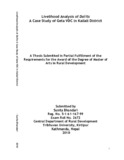Please use this identifier to cite or link to this item:
https://elibrary.tucl.edu.np/handle/123456789/3639| Title: | livelihood Analysis of Dalits a Case Study of Geta VDC in Kailali District |
| Authors: | Bhandari, Sunita |
| Keywords: | Dalits Situation;Gender;Agriculture;households |
| Issue Date: | 2010 |
| Publisher: | Department of Rural Development |
| Institute Name: | Central Department of Rural Development |
| Level: | Masters |
| Abstract: | The study was carried out in the purposively selected wards (4 and 5) of GetaVDC of Kailali district with the objectives of a) examining the socio-economicand livelihood conditions of Dalit, b) assessing their household level foodsecurity with respect to land holding size and c) finding out their livingstandard. Of the total 104 Dalit households, 66 households were sampled forthe study. Both qualitative and quantitative techniques were used for datacollection. The data analysis was done with the help of computer softwarepackages i.e. Microsoft Excel 2007. Sixty five respondents had some kind of land.Of these, 35 possessed Ailaniland (barren land owned by the government) and the rest had private land.For themajority, size of landholding was very small. The major crops grown inthe study area were rice, wheat, mustard, pulse crop and maize and theiryield rates were 3.2534 metric ton/ha, 1.7290 metric ton/ha, 0.2699 metricton/ha, 0.2381 metric ton/ha and 0.6288 metric ton/ha kg respectively. Forthe absolute majority, food they produced was only sufficient for less thanthree months. They supplemented their requirements with off-farm labour,farming and caste-based occupation. Those who earned less than NRs.3,000per month, 3,000 to 4,500 and more that NRs.4, 500 were almost equallydivided. Majority of the respondents owned some kind of livestock such asgoat, ox, cow, buffalo, calf and hen and had thatched houses. Very few hadaccess to electricity where as none of the Dalits had toilets in their houses.Most of the family members were just literate. However, they took loan fromboth formal and informal institutions. The average monthly expenditure onfood, education, health and clothing was NRs.3060.94. Nearly three-fifths(56.06%) of the respondents perceived their living standard as low and for therest, it was medium.The socio-economic condition of Dalits in all dimensions,such as sources of livelihoods, size of land holding, food security and other isat lower level. |
| URI: | http://elibrary.tucl.edu.np/handle/123456789/3639 |
| Appears in Collections: | Rural Development |
Files in This Item:
| File | Description | Size | Format | |
|---|---|---|---|---|
| COVER.pdf | 81.2 kB | Adobe PDF |  View/Open | |
| CHAPTER.pdf | 810.98 kB | Adobe PDF |  View/Open |
Items in DSpace are protected by copyright, with all rights reserved, unless otherwise indicated.
